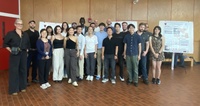Abstract:
Nanofiber production platforms commonly rely on volatile carrier solvents or high voltages. Production of nanofibers comprised of charged polymers or polymers requiring nonvolatile solvents thus typically requires customization of spinning setup and polymer dope. In severe cases, these challenges can hinder fiber formation entirely. Here, a versatile system is presented which addresses these challenges by employing centrifugal force to extrude polymer dope jet through an air gap, into a flowing precipitation bath. This voltage-free approach ensures that nanofiber solidification occurs in liquid, minimizing surface tension instability that results in jet breakup and fiber defects. In addition, nanofibers of controlled size and morphology can be fabricated by tuning spinning parameters including air gap length, spinning speed, polymer concentration, and bath composition. To demonstrate the versatility of our platform, para-aramid (e.g., Kevlar) and biopolymer (e.g., DNA, alginate) nanofibers are produced that cannot be readily produced using standard nanofiber production methods.
